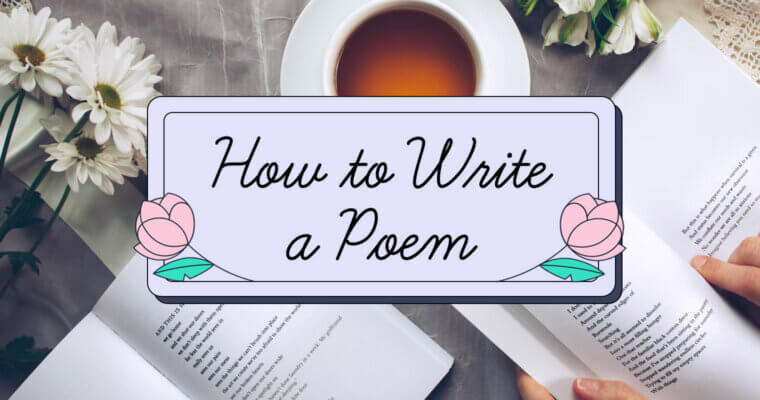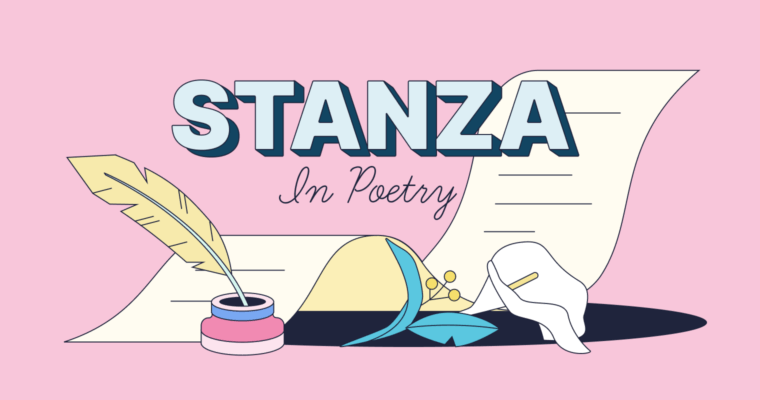
Poetry is . . . song lyrics without the music? Writing that rhymes? A bunch of comparisons and abstract imagery that feels like a code for the reader to decipher?
The answer to all of the above is yes, but poetry encompasses much more. Poetry is a broad literary category that covers everything from bawdy limericks to unforgettable song lyrics to the sentimental couplets inside greeting cards. Poetry’s lack of rules can make it feel hard to define but is also what makes poetry enjoyable for so many to write.
If you’ve ever wondered how to write a poem, read on. Writing poetry doesn’t have to be daunting—we’re going to demystify the process and walk you through it, one step at a time.
What is a poem?
A poem is a singular piece of poetry.
Poems don’t have to rhyme; they don’t have to fit any specific format; and they don’t have to use any specific vocabulary or be about any specific topic. But here’s what they do have to do: use words artistically by employing figurative language. With a poem, the form is as important as the function—perhaps even more so.
In contrast, prose is writing that follows the standard sentence and paragraph structure. Prose, while it takes many different forms and tones, largely mimics human speech patterns.
The purpose of a poem
Poetry expresses emotions and conveys ideas, but that’s not all it can do. Poets tell stories, teach lessons, and even communicate hidden messages through poetry. When you listen to music with lyrics, you’re listening to poetry.
When you’re writing poetry, keep your goal in mind. Are you writing to evoke emotion? To perform your poem at an open mic night? To get a good grade on your assignment? Although there aren’t any hard and fast rules for writing poetry, there are some fundamental guidelines to keep in mind:
- Show, don’t tell. The goal is to provoke an emotion in the reader.
- Less can be more. While it’s perfectly acceptable to write long, flowery verse, using simple, concise language is also powerful. Word choice and poem length are up to you.
- It’s OK to break grammatical rules when doing so helps you express yourself.
Elements of poetry
The key elements that distinguish poetry from other kinds of literature include sound, rhythm, rhyme, and format. The first three of these are apparent when you hear poetry read aloud. The last is most obvious when you read poetry.
One thing poetry has in common with other kinds of literature is its use of literary devices. Poems, like other kinds of creative writing, often make use of allegories and other kinds of figurative language to communicate themes.
Sound
In many cases, poetry is most impactful when it’s listened to rather than read. With this in mind, poets often create sound, whether to be pleasing, jarring, or simply highlight key phrases or images through words. Read this short poem “The Cold Wind Blows” by Kelly Roper aloud and listen to the sounds the letters and words make:
Who knows why the cold wind blows
Or where it goes, or what it knows.
It only flows in passionate throes
Until it finally slows and settles in repose.
Do you hear the repeated “ose” sound and how it mimics the sound of wind gusts? Poets create sound in a variety of ways, like alliteration, assonance, and consonance.
Rhythm
Poetry has rhythm. That’s what often makes it so attractive to set to music.
A poem’s rhythmic structure is known as its meter. Meter refers to:
- The number of syllables in each line
- The stressed and unstressed syllables in each line
These syllables are grouped together to form feet, units that make up a line of poetry. A foot is generally two or three syllables, and each combination of two or three stressed and unstressed syllables has a unique name.
You probably recognize the term iambic pentameter from English class. It comes up a lot in high school English classes because Shakespeare wrote in it frequently, and Shakespeare is frequently read in high school English classes. An iamb is a two-syllable foot where the second syllable is stressed: duh-DUH. Pentameter means that each line in the poem has five feet or ten total syllables.
Iambic pentameter is just one of the many kinds of rhythm a poem can have. Other types of feet include the trochee, two syllables where the first syllable is stressed (DUH-duh), and dactyl, three syllables where only the first is stressed (DUH-duh-duh). When a poem only has one foot per line, it’s in monometer; when there are two feet per line, it’s in dimeter; and so on.
Stressed and unstressed syllables aren’t the only way you can create rhythm in your poetry. Another technique poets frequently embrace is repetition. Repetition underscores the words being repeated, which could be a phrase or a single word. In her poem “Still I Rise”, Maya Angelou repeats the phrase “I rise” with increasing frequency as the poem progresses, changing it from “I’ll rise” in the first stanzas to a repeated “I rise” toward the ending, to emphasize her unbreakable spirit:
Leaving behind nights of terror and fear
I rise
Into a daybreak that’s wondrously clear
I rise
Bringing the gifts that my ancestors gave,
I am the dream and the hope of the slave.
I rise
I rise
I rise.
Rhyme
With poetry, rhythm and rhyme go hand in hand. Both create musicality in the poem, making it pleasurable to recite and listen to.
Rhymes can appear anywhere in a poem, not just at the ends of alternating lines. Take a look at all the places Lewis Carrol uses rhymes in this excerpt from “Jabberwocky”:
One, two! One, two! And through and through
The vorpal blade went snicker-snack!
He left it dead, and with its head
He went galumphing back.
Format
When you’re reading poetry, one of the first things you’ll likely notice is its formatting. Simply put, poems just aren’t formatted the same way as prose. Sentences end in weird places, there are blank lines between the different sections, one word might have a line all to itself, or the words might be arranged in a shape that makes a picture on the page.
One of poetry’s defining characteristics is that it doesn’t adhere to the same formatting that prose does. You (most likely) won’t find sentences and paragraphs in poetry. Instead, you’ll find stanzas, lines, and line breaks.
A stanza is the poetic equivalent of a paragraph. It’s a group of lines that (usually) adheres to a specific rhyme or rhythm pattern. For example, a quatrain is a four-line stanza in which the second and fourth lines rhyme. An isometric stanza is a stanza of any length where each line has the same meter.
Literary devices
Literary devices aren’t limited to prose—many, perhaps even most, poems incorporate one or more literary devices. Literary devices commonly found in poetry include:
- Figurative language
- Juxtaposition
- Onomatopoeia
- Simile
- Metaphor
- Puns
- Chiasmus
- Imagery
- Hyperbole
- Mood
- Motif
- Personification
Often, poets use literary devices in conjunction with other poetic elements. One famous example of a poem that layers multiple literary devices is Margaret Atwood’s “[you fit into me]”:
you fit into me
like a hook into an eye
a fish hook
an open eye
In the first stanza, Atwood uses a simile, a type of figurative language, to create an initially pleasant image: a hook and eye closure, a small metal hook that neatly fits into an appropriately sized metal loop to fasten clothing. Then the second stanza juxtaposes this with a jarring image: a fish hook plunged into an eyeball. These images together, formatted as two stark sections separated by a break, express the poem’s uncomfortable, visceral theme.
Types of poetic forms
There are many different types of poems. Some have very strict style rules, while others are classified according to the topics they cover rather than their structure. When you’re writing poetry, keep the form you’re writing in mind as you brainstorm—with forms that involve rhyming or require a specific number of syllables, you’ll probably want to jot down a list of go-to words that fit into your chosen format before you start writing.
Haiku
A haiku is a three-line poem that always fits this format: The first and third lines contain five syllables and the second line contains seven syllables.
Limerick
A limerick is a five-line poem that follows a strict AABBA rhyme scheme. Though they often discuss humorous subjects, this isn’t a requirement—the only requirement is that it fits this precise rhyme pattern.
Sonnet
A sonnet is a fourteen-line poem that was often used by Shakespeare and Petrarch. Although a sonnet’s exact rhyme scheme varies from poem to poem, each sonnet has some kind of consistent rhyme pattern.
Blank verse
Blank verse poetry is written in a specific meter that, as a rule, does not rhyme. Although this specific meter is often iambic pentameter, that isn’t a requirement for blank verse poetry—the only requirements are that it does not stray from its meter (whichever meter the poet chose) and that it doesn’t rhyme.
Free verse
With free verse, anything goes. When you read a poem that doesn’t appear to fit any specific format, you’re reading free verse poetry.
Ode
An ode is a poem that celebrates a person, an event, or even an object. An ode uses vivid language to describe its subject.
Elegy
Elegies are poems that, like odes, pay tribute to specific subjects. However, rather than being purely celebratory, an elegy is generally a reflection on its subject’s death and includes themes of mourning and loss.
How to write a poem
Writing a poem isn’t the same as writing a short story, an essay, an email, or any other type of writing. While each of these other kinds of writing requires a unique approach, they all have one thing in common: they’re prose.
Poetry isn’t prose, as we explained above. And that’s what makes it feel like the wildcard of creative writing.
With poetry, going through the standard writing process can feel like a creativity killer. That doesn’t mean you should just sit down, scrawl out a poem, and call it a day. On the contrary, when you’re writing poetry, you might find that skipping one or more stages in the traditional writing process will help you be more creative.
Of course, you might also find that following the writing process helps you explore and organize your thoughts before you start to write. The usefulness of starting with brainstorming, then moving onto outlining, then starting to write only once you’ve got an outline varies from poet to poet and even poem to poem. Sometimes, inspiration strikes and the words just start flowing out of your mind and onto the page.
Here are a few tips to help you get started and write your next poem:
1 Decide what you want to write about
Unless you’ve been assigned to write a poem about a specific topic, the first step in writing a poem is determining a topic to write about. Look for inspiration around you, perhaps in nature, your community, current events, or the people in your life. Take notes on how different things make you feel and what they drive you to think about.
Freewriting can be a helpful exercise when you’re searching for the perfect topic to write a poem about. You can use a writing prompt as a jumping-off point for your freewriting or just jot down a word (or a few) and see where your mind guides your pen, stream-of-consciousness style.
Once you have a topic and a theme in mind, the next step is to determine which kind of poem is the best way to express it.
2 Determine the best format for your topic
Your poem doesn’t have to adhere to any specific format, but choosing a format and sticking to it might be the way to go. By opting to write in a particular format, like a sonnet or a limerick, for example, you constrain your writing and force yourself to find a way to creatively express your theme while fitting that format’s constraints.
3 Explore words, rhymes, and rhythm
If you’ve decided to write your poem in a specific format, read other poems in that format to give yourself a template to follow. A specific rhythm or rhyme scheme can highlight themes and clever wordplay in your poem. For example, you might determine that a limerick is the most effective way to make your readers laugh at your satirical poem because the format feels like it has a built-in punchline.
4 Write the poem
Now it’s time to write! Whether you opt for using a pen and paper, typing on a laptop, or tapping on your phone, give yourself some uninterrupted time to focus on writing the poem.
Don’t expect to write something perfect on the first try. Instead, focus on getting your words out. Even if your lines don’t rhyme perfectly or you’ve got too many or too few syllables to fit the format you chose, write what’s on your mind. The theme your words are expressing is more important than the specific words themselves, and you can always revise your poem later.
5 Edit what you’ve written
Once you have a draft, the next step is to edit your poem. You don’t have to jump right from writing to editing—in fact, it’s better if you don’t. Give yourself a break. Then in a day or two, come back to your poem with a critical eye. By that, we mean read it again, taking note of any spots where you can replace a word with a stronger one, tighten your rhythm, make your imagery more vivid, or even remove words or stanzas that aren’t adding anything to the poem. When you do this, you might realize that the poem would work better in another form or that your poem would be stronger if it rhymed . . . or if it didn’t.
Reading your poem aloud can help you edit it more effectively because when you listen to it, you’ll hear the poem’s rhythm and quickly notice any spots where the rhythm doesn’t quite work. This can help you move words around or even completely restructure the poem.
If you’re comfortable sharing your poetry with others, have somebody else read your poem and give you feedback on ways you can improve it. You might even want to join a writing group, online or off, where you can workshop your poetry with other writers. Often, other people can spot strengths and weaknesses in your work that you might not have noticed because your perspective is too close to the poem. A more distanced perspective, as well as perspectives from readers and writers of different backgrounds, can offer up ways to make your writing stronger that you hadn’t considered before.
Give your writing extra spark
When you’re writing poetry, you’re allowed to break the rules. In fact, you’re encouraged to break the rules. Breaking the rules artistically is one of the key differences between writing poetry and writing prose.
But making mistakes isn’t the same as breaking the rules. Mistakes in your poetry, like misspelled words and incorrect punctuation, can distract readers from what you’re communicating through your words. That’s where Grammarly comes in. Grammarly catches any mistakes or tone inconsistencies in your work and suggests ways you can make your writing stronger. The outcome: writing with confidence and getting better at breaking the rules on purpose.






